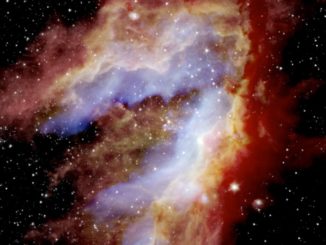The Swan Nebula, also known as M17 and the Omega Nebula, is a familiar target for amateur astronomers, easily visible in binoculars on clear summer nights while moderate-size telescope reveal an unmistakable, extended cloud of gas. But the European Southern Observatory’s Wide Field Imager on the MPG/ESO 2.2-metre telescope reveals the Swan in all of its brilliant majesty in this 2015 “Cosmic Gems” image. Discovered in 1745 by the Swiss astronomer Jean-Philippe Loys de Chéseaux, the Swan is some 5,000 light years away in the constellation Sagittarius, home to one of the Milky Way’s brightest and youngest star clusters. Charles Messier added it to his famous catalogue in 1764.

In 2017, ESO’s VLT Survey Telescope captured a three-gigapixel view of M17 and two nearby companions, the equally well known Eagle Nebula (M16) and Sharpless 2-54, all part of a vast reservoir of gas and dust that serves as an enormous stellar nursery.




